Wai-Fah Chen.The Civil Engineering Handbook
Подождите немного. Документ загружается.

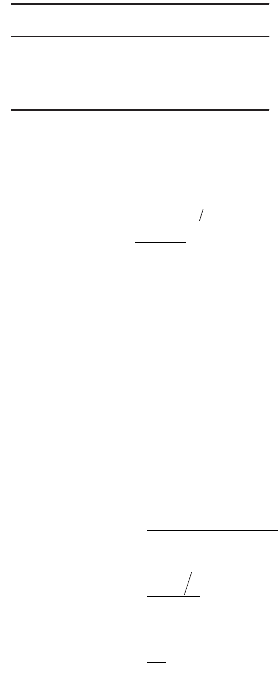
12-30 The Civil Engineering Handbook, Second Edition
Selecting which particle terminal settling velocity equation to use is more easily and accurately done
by forming the following K criterion:
(12.17)
and selecting the flow regime according to the value of K in Table 12.8.
Cyclones
Particle aerodynamic diameters from 40 down to 10 microns are usually removed from a gas stream by
cyclonic separation. In this smaller particle diameter range, an additional force, namely centrifugal force,
must be applied to effect their removal. In the case of the settling chamber for larger particles, one g force
was utilized. With the cyclone, many equivalent g forces are utilized via centrifugal force. A ratio of the
centrifugal to gravitational force is called the separation factor of the cyclone:
(12.18)
For cyclones this separation factor can be as high as 2500, which means 2500 gs of force are applied
to the particles as compared to 1 g in a settling chamber. A cyclonic separator can be thought of as a
settling chamber of revolution. In other words, the cyclone is also a wide spot in the exhaust gas duct
which provides sufficient residence time for the centrifugal forces to act and remove the particles from
the gas stream.
A conventional cyclone consists of a tangential entry, a main cylinder section, a conical lower section
with provision for particle removal, and a gas outlet tube, as shown in Fig. 12.6. The gas enters the main
cylinder tangentially and spirals downward (forming the primary vortex) into the conical section, thus
imposing a centrifugal force on the entrained particles which move radially outward, impacting the side
walls and falling to the bottom of the cyclone. Since there is no gas exit at the bottom of the cyclone, the
primary vortex downward movement stops, the spiral tightens (now called the secondary vortex) and
moves vertically up and out of the top of the cyclone through the outlet tube. The size of these cyclones
can vary from 2 feet in diameter up to 12 to 15 feet in diameter. Figure 12.7 shows the dimensional
labeling for a typical tangential entry cyclone. The conventional cyclone design geometry dimensional
relationships as given by Lapple are shown in Table 12.9. Note that each of the lengths are proportional
to the main body diameter of the cyclone. Once the main body diameter is chosen, the remaining lengths
are set.
Since Lapple’s original work on the conventional cyclone, other researchers have suggested geometry
ratios slightly different from that of Lapple. These geometries are shown in Table 12.9, and have been
identified as “high efficiency” and “high throughput.”
TABLE 12.8 Flow Regime K Values
Flow Regime K Range
Stokes K £ 3.3
Intermediate 3.3 £ K £ 43.6
Turbulent 43.6 £ K £ 2360
Kd
g
p
pf
f
=
Ê
Ë
Á
ˆ
¯
˜
rr
m
2
13
Separation force
Centrifugal force
Gravity force
=
=
=
mV r
mg
v
rg
2
2
© 2003 by CRC Press LLC

Air Pollution 12-31
Conventional Cyclone Design Approach
In the 1950s, Lapple correlated the collection efficiency data from many sizes of conventional cyclones
using a “cut-diameter” variable. This correlation, seen in Fig. 12.8, is the classic approach to designing
FIGURE 12.6 Cyclone. (Source: Cooper, C. D. and Alley, F. C. 1990. Air Pollution Control: A Design Approach.
Waveland Press, Prospect Heights, IL. Reprinted by permission of Waveland Press, Inc. All rights reserved.)
FIGURE 12.7 Dimensionally labeled cyclone. (Source: Cooper, C. D. and Alley, F. C. 1990. Air Pollution Control: A
Design Approach. Waveland Press, Prospect Heights, IL. Reprinted by permission of Waveland Press, Inc. All right
reserved.)
Gas flow path
Vortex-finder tube
Cleaned gas out
Tangential
inlet duct
Dusty
gas in
Dust out
H
S
D
W
D
e
L
b
L
c
D
d
© 2003 by CRC Press LLC
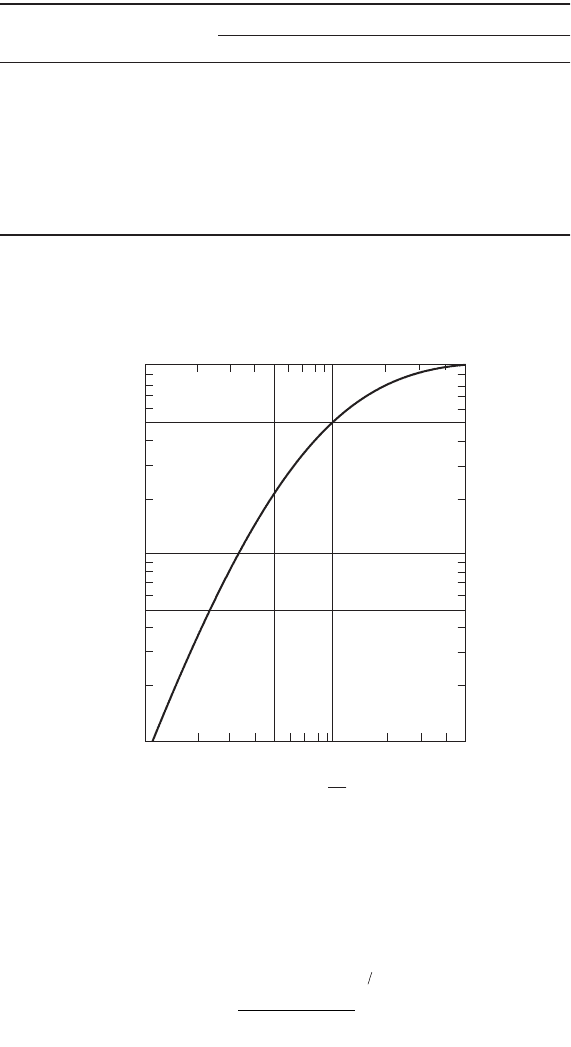
12-32 The Civil Engineering Handbook, Second Edition
and sizing a conventional cyclone. The cut-diameter is that diameter of particle captured at a 50%
efficiency in the cyclone. It is calculated from the following equation:
(12.19)
where d
pc
is the cyclone cut-diameter, m is the gas velocity, W
i
is the inlet width of the cyclone, v
i
is the
inlet gas velocity, r
p
and r
g
are the particle and gas densities, respectively, and N is the number of primary
vortex revolutions. N can be estimated by the ratio of L
b
/H (refer to Fig. 12.6).
Once the cut-diameter d
pc
is calculated, the Lapple nondimensional ratio, D
p
/D
pc
can be formed and
Fig. 12.8 used to determine the specific collection efficiency of the particles of interest. The overall
TABLE 12.9 Lapple Design Values for Cyclones
Cyclone Type
High Efficiency Conventional High Throughput
Body diameter, D/D 1.0 1.0 1.0
Height of inlet, H/D 0.5 0.5 0.75
Width of inlet, W/D 0.2 0.25 0.375
Diameter of gas exit, D
e
/D 0.5 0.5 0.75
Length of vortex finder, S/D 0.5 0.625 0.875
Length of body, L
b
/D 1.5 2.0 1.5
Length of cone, L
c
/D 2.5 2.0 2.5
Diameter of dust outlet, D
d
/D 0.375 0.25 0.375
Source: Cooper, C. D. and Alley, F. C. 1990. Air Pollution Control: A Design Approach.
Waveland Press, Prospect Heights, IL. Reprinted by permission of Waveland Press, Inc.
All rights reserved.
FIGURE 12.8 Cut diameter (Source: Cooper, C. D. and Alley, F. C. 1990. Air Pollution Control: A Design Approach.
Waveland Press, Prospect Heights, IL. Reprinted by permission of Waveland Press, Inc. All rights reserved.)
100
50
10
5
1
0.1 0.5 1.0 2.0 3.0 4.0 5.0
Particle-size ratio
d
p
d
pc
η%
d
W
Nv
p
i
ip g
=
-
()
Ê
Ë
Á
Á
ˆ
¯
˜
˜
9
2
12
m
prr
© 2003 by CRC Press LLC
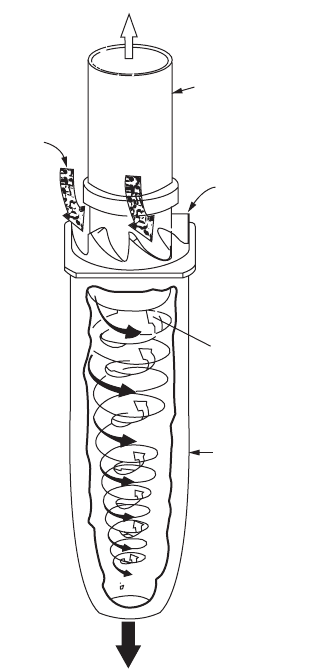
Air Pollution 12-33
collection efficiency of the cyclone is the summation of the specific efficiency from each size range chosen
weighted according to the mass of particles in each size range.
Another version of a cyclonic separator is the axial flow cyclone shown in Fig. 12.9. These units are
usually much smaller than the conventional unit and are usually ganged together in parallel to increase
the amount of gas they process. These units vary in size from a few inches to 18 inches in diameter.
Wet Scrubbers
Where gravity or centrifugal forces fail to remove smaller particles, wet scrubbers can be employed.
However, keep in mind that the wet scrubber merely converts an air pollution problem into a water
pollution problem. The wet scrubber presents a liquid, usually water, into a particulate-laden gas stream
where the liquid droplets and particles are brought together. Upon contact, the particle is surrounded by
liquid and the apparent mass of the original particle is increased. The particles, now with a greater apparent
mass, can be removed from the gas stream using straightforward impaction or cyclonic mechanisms.
Generally, the smaller the particle to be removed, the greater the energy input into the scrubber for
effective particulate removal. The water- and particulate-laden gas stream can be brought together in a
number of different ways. One common way is to inject the water through spray nozzles into the relatively
low-velocity gas stream. These low-energy wet scrubbers are referred to as spray chamber scrubbers and
are usually effective only for relatively large particles greater than 5 microns. The spray nozzles relative
to the gas stream are usually arranged cocurrent, countercurrent, or crosscurrent using a cone-type spray
FIGURE 12.9 Axial flow cyclone.
Clear
air
Outlet
tube
Dust-loden
air
Inlet
vanes
Clean air
discharged upward
Collection
tube
Dust
discharge
© 2003 by CRC Press LLC
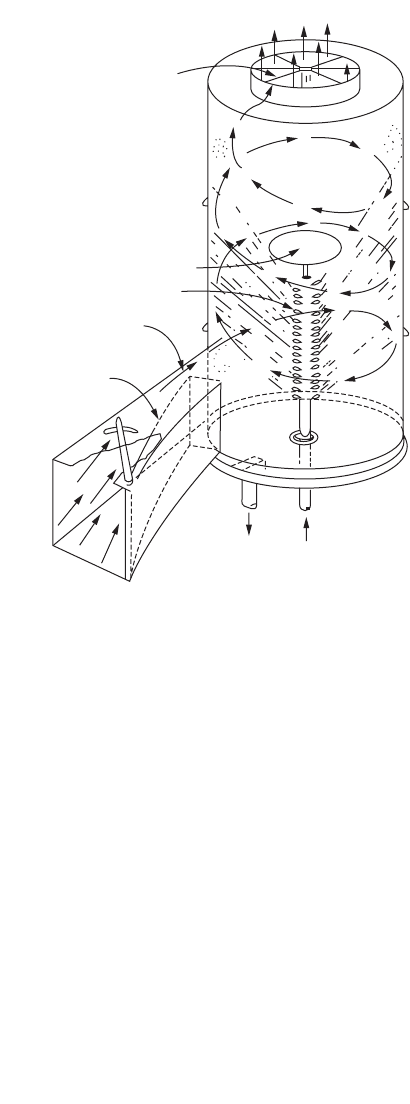
12-34 The Civil Engineering Handbook, Second Edition
pattern with liquid requirements from 15 to 25 gallons/1000 ft
3
at a liquid delivery pressure of about
40 psi. There are literally hundreds of spray chamber scrubber configurations on the market. Figure 12.10
shows a typical configuration.
Other methods of bringing the water and particulate matter together involve impaction of a liquid
droplet–gas mixture on a solid surface. In orifice scrubbers, the gas impinges on a liquid surface and
then the droplet–gas mixture must negotiate a series of tortuous turns through a baffle arrangement. In
impingement scrubbers the liquid droplet–gas mixture flows upward through perforated trays containing
liquid and froth and then impacts on plates above the trays.
High-efficiency scrubbers for submicron particulate matter accelerate the gas stream in a venturi and
present the liquid to the gas near the throat of the venturi. These venturi scrubbers are very effective for
submicron particulate removal and operate with relatively high gas–side pressure drops from approximately
20 to 120 inches–water column. As a result they are energy intensive and have high operational costs.
However, they can achieve collection efficiencies of 93% or greater on particles larger than 0.3 microns
[Cooper and Alley, 1990].
The general equation for overall wet scrubber particulate removal efficiency is given by
(12.20)
where f
(system)
is a term representing some function of the particular scrubber system variables. The form
of this equation predicts an exponentially increasing collection efficiency with particle diameter and
asymptotically approaches 100%.
FIGURE 12.10 Wet scrubber. (Source: Cooper, C. D. and Alley, F. C. 1990. Air Pollution Control: A Design Approach.
Waveland Press, Prospect Heights, IL. Reprinted by permission of Waveland Press, Inc. All rights reserved.)
Cleaned gas
Straightening
vanes
Core buster disc
Spray manifold
Tangential
gas inlet
Swinging inlet
damper
Dirty
gas
inlet
Water
outlet
Water
inlet
Ne
f
system
=-
-
()
1
© 2003 by CRC Press LLC
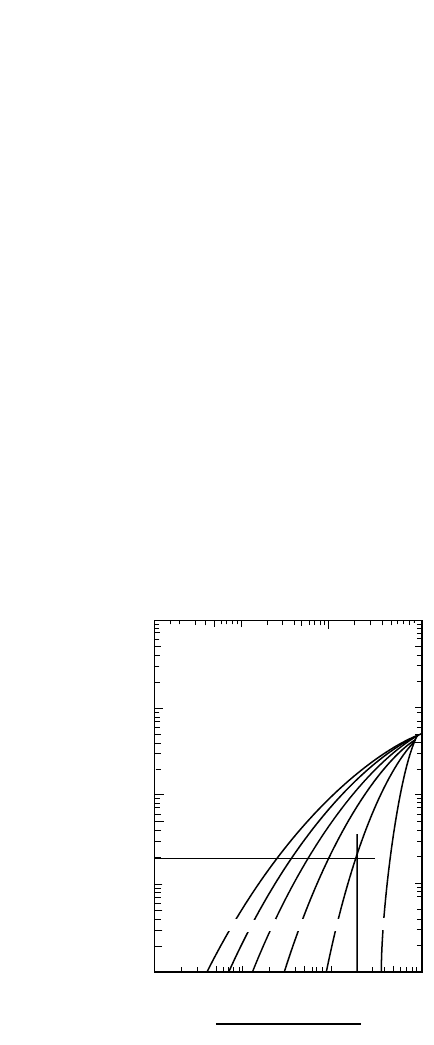
Air Pollution 12-35
Wet Scrubber Design Approach
Calvert suggests a design approach based on a single droplet target efficiency, impaction parameter and
the concept of particle penetration [Calvert, 1972]. Penetration is defined as the converse of collection
efficiency:
(12.21)
where N is the particle collection efficiency fraction and P is the fraction of particles that escape (or
penetrate) the collection device.
Combining the general efficiency and penetration equations yields
(12.22)
or P = e
–f
(system)
. Calvert defines f
(system)
as an empirical function dependent on the particle aerodynamic
diameter, d
p
. Now:
(12.23)
where A
cut
is a parameter which characterizes the particulate aerodynamic size distribution and B
cut
is an
empirical constant of 2.0 for plate towers and venturi scrubbers and 0.7 for centrifugal scrubbers. The
penetration is now:
(12.24)
which yields the penetration for one particle size distribution. The overall penetration is the summation
of the penetration from each chosen size range weighted according to the mass of particles in each size
range.
By integrating the penetration, P, over a lognormal size distribution of particles and various geometric
standard deviations and mass median diameters, Calvert developed the curves in Fig. 12.11. Knowing
FIGURE 12.11 Calvert design curves (B
cut
= 2).
PN=-1
Pe
f
system
=- -
Ê
Ë
ˆ
¯
-
()
11
fAd
system
p
B
()
=
cut
cut
Pe
Ad
cut P
Bcut
=
-
6
5
4
3
2
= 1
σ
gm
10
1.0
0.1
0.01
0.001
0.01 0.1 1.00.001
Particle Cut Diameter
Geometric Std. Dev.
Overall
Penetration, P
© 2003 by CRC Press LLC

12-36 The Civil Engineering Handbook, Second Edition
the required overall collection efficiency of the scrubber and the mass median diameter of the particle
size distribution challenging the scrubber, the cut size of the scrubber can be determined.
Consider this example: an in situ aerodynamic particle size sample and subsequent gravimetric analysis
indicated that the mass median diameter of the distribution was 10 microns and the geometric standard
deviation of the distribution was 2.0. If a collection efficiency of 98% is required to meet the emission
standards what must the cut diameter of a venturi (B
cut
= 2) scrubber be?
(12.25)
Now from Fig. 12.11, for P = 0.02 and SD = 2.0 microns, dp
50
/dp
gm
= 0.185 and, therefore, dp
50
= dp
gm
¥
0.185 = 10 ¥ 0.185 = 1.85 microns. In this example, the scrubber must collect the 1.85-micron particles
with an efficiency of at least 50% to meet the overall scrubber efficiency of 98%.
Fabric Filters
Where it is not desired to create a water pollution problem from an air pollution problem, dry collection
of fine particulate matter in gas streams can be very effectively accomplished using baghouse filtration.
Baghouses have been around for quite some time and their usefulness is continually being extended due
to advances in the media or substrate material onto which the particles are being collected. The “heart”
of a baghouse filtration system is the media which acts as a substrate for collection of a filter “cake” which
ultimately does the “filtering.”
Baghouses are typically grouped into three classes based on the method employed to clean the filtration
media: reverse air, shaker, and pulse jet. The reverse air baghouse is cleaned by taking the baghouse
compartment to be cleaned out of operation and reversing the air flow through the filter, thus removing
the cake from the filtration bags. A shaker baghouse also has a compartment taken out of service and
mechanically shakes the bags to dislodge the filter cake physically. The most recent innovation in baghouse
cleaning consists of the pulse-jet baghouse. This type of baghouse is cleaned by pulsing high pressure
blasts of air through the interior of the bag while the bag is in service.
Filtration Media
Many different types of fabrics are used in baghouse filters. Fiberglass and even ceramic fibers are used
in high-temperature applications. More commonly used are cotton, polyesters, and teflon coatings.
Matching the proper bag material with the gas stream characteristics is extremely important for long bag
life. Table 12.10 is an example of some of the more popular fabric materials with their temperature
limitations and acid, alkali, and flexure/abrasion resistance.
As can be seen from Table 12.10, most conventional fibers are limited to operating temperatures less
than 260°C (500°F). Nextel® is a relatively new high-temperature fiber developed by 3M which has an
upper temperature limit of 760°C (1400°F). The fiber is made of continuous individual ceramic filaments.
The technology is based on a “sol-gel” process whereby a chemical sol is extruded through a spinneret
and then fired. The resulting metal oxide fibers are polycrystalline woven fiberglass [Hansen, 1994].
Sintamatic™, a filter matrix consisting of Teflon (PTFE)-coated polyethylene beads sintered into a
rigid matrix, is a newer technology in baghouse filter media. As opposed to flexible fabric material, this
media is configured in rectangular, hollow, fan-fold rigid panels affixed to an air manifold. The vertically
oriented, fan-fold, rigid panels are ganged together in parallel units. Filtration takes place across the
outside of the fan-fold panel with the cleaned gas proceeding into the hollow interior space in each panel
and up into the clean air manifold.
Since the media is composed of polyethylene and PTFE it is very resistant to acids and bases. However,
the major hindrance is temperature; it has an upper limit of about 140°F. A scanning electron microscope
was used to examine a cross section of the media [Pedersen, 1993]. Figure 12.12 shows the media
magnified 72 times with the horizontal white bar in the lower right of the photo representing 100 microns.
PN=-
=-
=
1
1098
002
.
.
© 2003 by CRC Press LLC
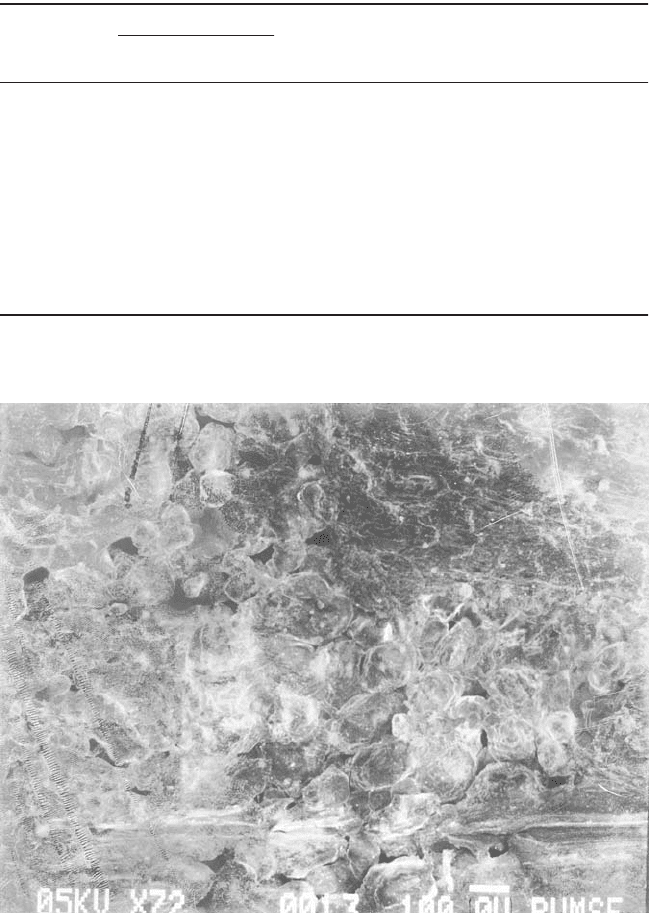
Air Pollution 12-37
Most of the polyethylene beads are between approximately 50 and 200 microns, with the average being
100 microns. Most of the visible pores appear to be smaller than 100 microns. An analysis of the pore
structure indicated the media porosity to be about 0.054 [Pedersen, 1993]. This author has sampled a
Sintamatic baghouse handling toxic metal dusts in an ambient air stream and found the unit to perform
extremely well.
Air-to-Cloth Ratio
The primary design variable for a baghouse filter is the air-to-cloth ratio (A/C) which is the actual air
flow rate through the baghouse divided by the filtration or cloth area. The A/C has units of meters/min
TA BLE 12.10 Properties of Filter Fabrics
Maximum Temperature
Continuous Surge Acid Alkaline Flex
Material (°C) (°C) Resistance Resistance Abrasion Relative Cost
Cotton 82 107 P VG VG 2
Polypropylene 88 93 P–EX VG EX 1.5
Wo ol 93–102 121 VG P F–G 3
Nylon 93–107 121 P–F G–EX EX 2.5
Orlon 116 127 EX F–G G 2.75
Acrylic 127 137 G F G 3
Dacron 135 163 G G VG 2.8
Nomex 204 218 P–G G–EX EX 8
Te flon 204–232 260 EX EX F 25
Fiberglass 260 288 F–G F–G F 6
Nextel® 760 1200 G–EX EX–G EX High
P — poor, F — fair, G — good, VG — very good, EX — excellent.
FIGURE 12.12 Sintamatic filter media.
© 2003 by CRC Press LLC

12-38 The Civil Engineering Handbook, Second Edition
and ranges from 1.0 to 7.7 cm/s (2.0 to 15.0 ft/min). A very conservative design has A/C ratios around
1.0 cm/s (2.0 ft/min) while most industrial applications are in the 2.5 to 3.0 cm/s (5 to 6 ft/min) A/C
range. Applications in aggregate crushing, sand reclaiming operations, and other applications where the
particulate matter is relatively large in diameter and easily cleaned off the surface of the filter media can
use A/C ratios between 3.0 to 7.7 cm/s (6 to 15 ft/min).
The selection of an optimum A/C ratio depends on the cleaning method, type of filter media, tem-
perature, and the characteristics of the particles. Also involved are the trade-offs between initial cost and
future operation and maintenance costs. A lower A/C means lower power cost, less maintenance, and
higher dust collection efficiency. However, a low A/C also means more filter area and higher initial cost.
Assuming no short-circuiting of inlet gas is occurring around the bags within the baghouse, poor
collection efficiencies usually result from too high an air-to-cloth ratio for the application. Returning to
conservative A/C ratios in the range of 2.0 or even 1.0 solves most former baghouse failure problems.
Baghouses typically have overall collection efficiencies greater than 98% for particles less than
10 microns in aerodynamic diameter. Therefore, they are widely used when high collection efficiencies
for relatively small particulate matter are required. Their high collection efficiency is due to three
mechanisms of impaction, interception, and diffusion acting simultaneously to remove particles down
into the submicron size range.
For the environmental engineer, the challenge is to properly match one of the various types of
baghouses available with the gas stream and the particulate matter to be collected.
Gas Conditioning
Since most baghouses are not very tolerant of high temperatures and moisture condensation, conditioning
of the challenge gas streams is an extremely important consideration. High temperatures can cause bag
media failure and even fires. Gas-entrained sparks or static electricity buildup can also cause fires and
explosions. If water vapor within the gas stream is allowed to condense on the filter cake, the cake turns
to mud, the pressure drop rises rapidly and the filter media becomes impervious to airflow or “blinds.”
High gas temperatures and moisture condensation must be avoided in baghouse systems. Three methods
of reducing baghouse inlet gas temperatures are ambient air dilution, radiation and free convection, and
water injection. A starting point common to the selection or design of any cooling method is the
calculation of the heat energy that must be removed from the gas stream prior to baghouse entry.
Gas Stream Cooling Requirements
The following heat transfer rate equation is used to calculate the heat energy that must be removed from
the gas stream:
(12.26)
where q is the heat removed in Btu/hr; m is the mass flow rate of gas in lb/hr; c
p
is the specific heat of
the gas at constant pressure in Btu/lb, °F; T
p
is the process gas temperature; and T
bi
is the baghouse gas
inlet temperature in degrees Fahrenheit. Regardless of the method of gas cooling that is employed prior
to baghouse entry, the amount of heat to be removed from the gas stream is the same for the three
methods.
Ambient Air Dilution
Mixing ambient air with the hot process gas prior to baghouse entry is an effective method of cooling.
Even in some systems employing other methods of cooling, emergency cooling is usually affected by
dilution with ambient air. Usually, a simple tee employing a butterfly valve in the ambient air leg is
inserted in the duct just upstream of the baghouse. A temperature-controlled modulating valve driver
can be used to position the butterfly valve and maintain the desired inlet baghouse gas temperature.
The following heat transfer rate equation can be solved for the desired mass flow rate of dilution air
to maintain the inlet baghouse gas temperature below desired limits:
qmcT T
pp bi
=-
()
© 2003 by CRC Press LLC

Air Pollution 12-39
(12.27)
where q is the heat energy to be removed from the process gas stream, Btu/hr; c
p
is the specific heat of
the ambient air, 0.24 Btu/lb, °F; T
bi
is the baghouse inlet gas temperature; and T
amb
is the ambient dilution
air temperature, °F.
Now the dilution air volume flow rate, Q, is calculated from
(12.28)
where r
bi
air
is the density of the gas entering the baghouse, lb/ft
3
.
While this method is effective for cooling, it must be pointed out that the dilution air volume flow
rate is a significant portion of the total gas the baghouse must now handle. In some situations, depending
on the original process gas temperature, the dilution air flow rate will exceed the process gas flow rate.
Therefore, the main disadvantage with this method of cooling is the added gas that the baghouse must
now process.
Radiation and Free Convection
This cooling method employs a long duct for radiation and free convection gas cooling between the
process and the baghouse. With this method, the heat energy needed to be removed from the gas stream
can be calculated from the following equation:
(12.29)
or
(12.30)
where U
combined
is the overall heat transfer coefficient of the cooling duct, Btu/(hr ft
2
°F); A is the exterior
duct area for heat transfer; and LMTD is the log mean temperature difference between the cooling duct
and the ambient air. Since we are interested in the diameter and length required for the cooling duct,
the above equation is solved for the heat transfer area, A, as
(12.31)
and for a chosen diameter,
(12.32)
Radiation and free convection cooling has the distinct advantage over the dilution cooling scheme in that
the gas handled by the baghouse contains no added dilution air and, therefore, is significantly less in
volume flow. There is the added expense of the ductwork, but this is usually more than offset by the
reduction in the amount of gas passing through the baghouse. Since the controlling thermal resistance in
this cooling method is the internal duct wall convective heat transfer coefficient, schemes to spray water
on the external surface of the pipe to significantly reduce the required pipe length are usually not successful.
This cooling method can require up to a few hundred feet of cooling duct, so there must be ample
room available at the site for successful implementation. Where space is available, long horizontal duct
runs have worked successfully; where space is at a premium, serpentine configurations can be used
effectively.
m
q
cTT
pbi
air
amb
air
=
-
()
Q
m
bi
=
air
air
r
qq q=+
free convection radiation
qU A=
()
combined
LMTD
ADL
q
U
==p
combined
LMTD
L
q
UD
=
combined
LMTDp
© 2003 by CRC Press LLC
